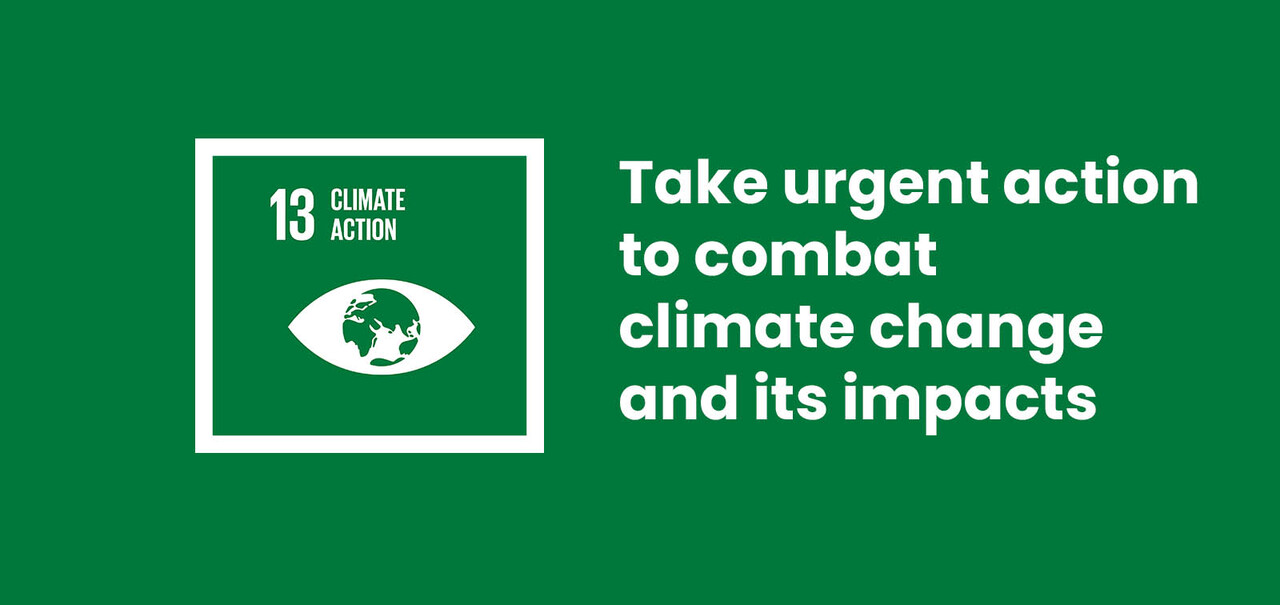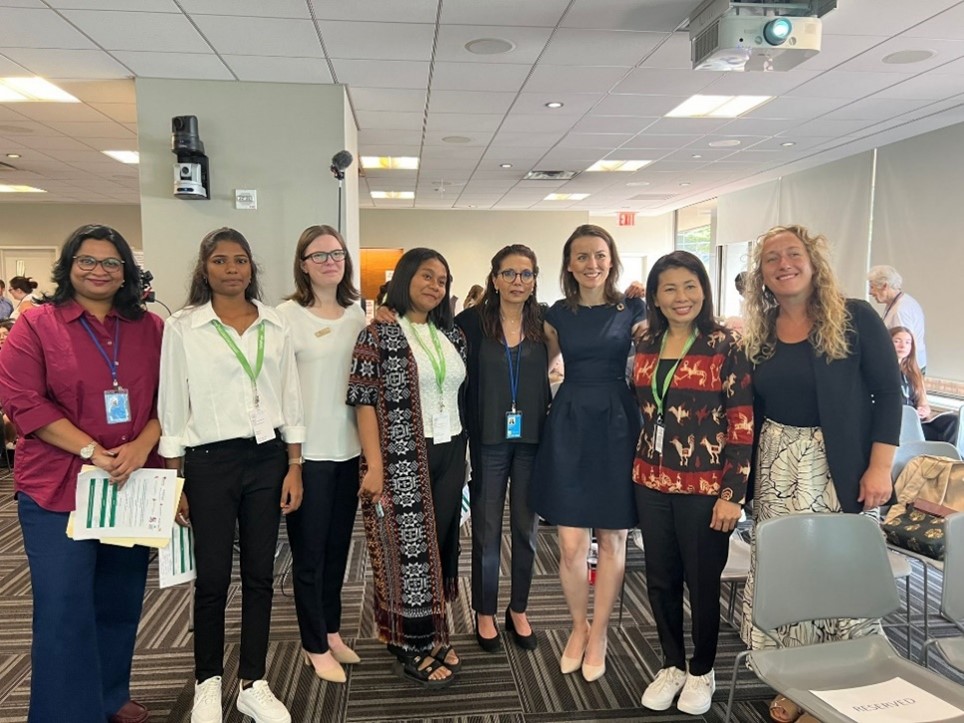Site will be
unavailable for maintenance from June. 4, 11:30 p.m., to June 5, 12:30 a.m. ET. Thank you for your
patience!
We Must Center Children and Youth in Climate Action: Reflections from the United Nations’ HLPF 2024
By Keeva Duffey, Sr. Advisor, Climate Action Posted on 09/06/2024
What were you doing on July 22, 2024? If you were in New York or thereabouts, you would have been sweltering in the heat. Did you know that day in particular was the warmest day on earth in recent history?
I was in New York too and experienced it firsthand. It wasn’t just me. Many others, especially children, were also experiencing it all around the world. This is why it is imperative that we include children's voices and their lived experiences in discussions about climate action, because it will be their future to take on these challenges.
The High-Level Political Forum (HLPF), which is the United Nations’ main event focused on sustainable development, is held in New York every year. This year, it was held from July 8-17. It was critical to bring children’s voices to the Forum. On July 10, the ChildFund Alliance and its members ChildFund International, Barnfonden and Children Believe joined forces with World Vision, Save the Children and Caritas to co-host an HLPF side event titled “The Intersectionality of Climate Insecurity and Violence Against Children,” aiming to highlight this crucial issue within the forum. Children from ChildFund International, Barnfonden and Children Believe climate action projects in South Asia joined a panel of children and youth. I was also a panelist, bringing insights from our programs across our 23 countries.
The HLPF is an extremely significant event as it has a central, global-level role in the follow-up and review of the 2030 Agenda for Sustainable Development and the Sustainable Development Goals (SDGs). The SDGs are a universal call to action to end poverty, protect the planet and ensure that by 2030, all people enjoy peace and prosperity. The 2024 HLPF reviewed SDGs 1 (No Poverty), 2 (Zero Hunger), 13 (Climate Action), 16 (Promote Peaceful and Inclusive Societies for Sustainable Development) and 17 (Partnerships for the SDGs) and all the targets under each goal. ChildFund's involvement in the Forum was crucial, since SDGs 1, 2, 13 and 16 are integral to ensuring that children grow up healthy, educated, skilled and safe.
The nine-day event was full of daily negotiations, high-level discussions and side events centered around the theme, “Reinforcing the 2030 agenda and eradicating poverty in times of multiple crises: the effective delivery of sustainable, resilient and innovative solutions.” On Wednesday, July 10, HLPF discussed Goal 13 – Climate Action. That day, ChildFund and its partners organized the side event focusing on the intersection between climate change and violence against children (SDGs 13 and 16). During the day’s forum, countries emphasized the urgent need for accelerated action to combat climate change and its impacts, highlighting that the world is not on track to meet our goal for SDG 13 and its targets:
- 1. Strengthen resilience and adaptive capacity to climate-related disasters.
- 2. Integrate climate change measures into policies and planning.
- 3. Build knowledge and capacity to meet climate change.

In fact, only 17% of all SDG targets are on track to be reached by 2030.
As a climate advisor, hearing this kind of report so often is nothing new for me. We are NOT on track, and we haven’t been on track for a long time. The world is getting warmer, leading to irregular weather patterns and more intense and extreme events. Honestly, the extreme heat in NYC during the week of discussions around achieving our climate action goal underlined how far off track we are. And the Copernicus Climate Change Service (C3S) data affirmed it. Their data shows that July 22, 2024, was the warmest day on earth in recent history. The month of June marked 12 consecutive months of the global temperature reaching 1.5C above pre-industrial levels (1.5C is the Paris Agreement threshold to stay under and maintain by 2030).
Discussions at the forum around climate change centered around the importance of accelerating climate action, building resilience in vulnerable communities and ecosystems, and mobilizing funding to the people most affected. Another important point being made was the need for just transitions — that is, transitions that are just, ensuring that the shift to a low-carbon economy is equitable and inclusive and protects workers and communities. Furthermore, a key climate change document launched at the Forum was the 2024 Global Report on Climate and SDG Synergy, titled Synergy Solutions for Climate and SDG Action: Bridging the Ambition Gap for the Future We Want. The report states that 80% of all SDGs and targets are linked to climate (positively or negatively) and that climate change will affect the achievement of at least 60% of them. Sadly, this report highlighted no child-centric content relevant to the current climate crisis that endangers them today. High-level climate events and reports seldom mention children, and young people are usually grouped with other marginalized groups. Considering how climate change affects children's rights and protection, the absence of a child-focused approach in discussions on SDG 13 was a significant missed opportunity.
Why we need to center children and youth in climate action
According to recent research, more intense climate related events will be experienced by children born this decade more than someone born in the 1960s. Climate change has increased, compounding and overlapping risks on children, magnifying their vulnerabilities and hobbling their ability to access quality essential services.
We must adapt to the reality that many children and young people will not experience the world as their parents did.
At ChildFund, our work with vulnerable communities is directly affected by climate change impacts, from climate stresses on livelihoods leading to risks from malnutrition to negative coping strategies by families (child marriage/labor) to unsafe conditions at school or home to forced migration due to extreme weather events. The climate crisis is seen as a threat multiplier on existing vulnerabilities and inequalities in society in general, but the threats are multiplied for children. Climate discussions like the ones held at HLPF need to account for child and youth needs and challenges, but unfortunately, it was barely mentioned.
“We need adults to take us seriously when we voice our concerns about climate change.”
—Kristyna, young leader from Czechia, who spoke up at the forum
The event was held in a packed, abnormally warm room with observers from all generations eager to listen to children and youth on the topic of climate change. The young speakers were joined by some high-level officials, including Dr. Najat Malla M’jid, the U.N.’s Special Representative of the Secretary-General on Violence Against Children; H.E. Mr. Olivier Maes from the Permanent Mission of Luxembourg to the United Nations; Justine Micallef, First Secretary, Permanent Mission of Malta to the United Nations; and Fatou Jeng, Climate Advisor to the United Nations Secretary-General (YAG), who kicked off the event with bold calls for scaled-up action to address the increased risks of violence against children due to increased, intensified multiple crises linked to climate change.
 Photo taken before the event with the child and youth panelists. L to R: Lavanya, Program Director (Children Believe India); Sathana, young leader from India (Children Believe India); Alice, young leader from Australia (Caritas); Ana, young leader from Indonesia (ChildFund Indonesia); Dr. Najat Malla M’jid, U.N. Special Representative of the Secretary-General on Violence Against Children; Kristyna, young leader from Czechia (Caritas); Reny, Child Protection Specialist (ChildFund Indonesia); and Keeva, Sr. Advisor, Climate Action (ChildFund International).
Photo taken before the event with the child and youth panelists. L to R: Lavanya, Program Director (Children Believe India); Sathana, young leader from India (Children Believe India); Alice, young leader from Australia (Caritas); Ana, young leader from Indonesia (ChildFund Indonesia); Dr. Najat Malla M’jid, U.N. Special Representative of the Secretary-General on Violence Against Children; Kristyna, young leader from Czechia (Caritas); Reny, Child Protection Specialist (ChildFund Indonesia); and Keeva, Sr. Advisor, Climate Action (ChildFund International).
The children and young speakers described the challenges of how climate change impacts children’s lives worldwide, as well as practical ways they have tried to overcome these challenges. Their experiences included disrupted schooling, malnutrition and migration due to unmet basic family needs, as well as loss of culture and identity linked with nature loss. They told of being undermined by older generations for wanting to act, and the anxious feeling of bearing the burden of a problem they did not create.
Key takeaways on youth-centered climate action
Children and youth need support. They need collective urgent action, and they need their voices to be heard.
I highlighted four key takeaways from ChildFund’s experiences and work on child- and youth-centered climate action:
1. We must enable meaningful child and youth engagement in climate policies at all levels — where children and youth are not only heard but actively participate in shaping the design, planning, implementation and evaluation of climate policies and initiatives at all levels. This entails inclusion of marginalized groups, including girls and rural and indigenous populations, so that their needs are at the center of interventions, and we leave no child behind.
2. We have to recognize and support the mental health of children and youth in climate discussions. Climate change is an injustice issue: Children and youth are bearing a burden they did not create. We must teach coping strategies and resilience-building techniques, ensure psychological safety and train facilitators in basic mental health literacy.
3. We must respect and encourage child and youth participation without overburdening them with the responsibility of solving climate change. They have the right to a childhood.
4. We must recognize the role climate change plays in increasing violence against children, and how this violence extends beyond disasters. The pervasive and gradual effects on individuals, families and communities heighten the risks of child labor, child marriage, recruitment of child soldiers, domestic abuse and violence within educational settings.
The final report of the forum is yet to be released and might be coupled with the Summit of the Future happening in late September, another high-level event which has the opportunity to center children and youth voices and meaningful participation on the key decisions that affect them now and in the future.
I hope the report will mention children and youth in the context of climate change more than the 2024 Global Report did. We drastically need to be more inclusive of children and youth in climate action across all levels. We must urgently act on behalf of children and their future — to leave them a world safe and clean, a world that we want pass down and be proud of. Everyone has a role, and although actions may look different and will be different across context and personal situation, there is still a chance for us to make this world a better place. And the only way there is together.
Loading...

